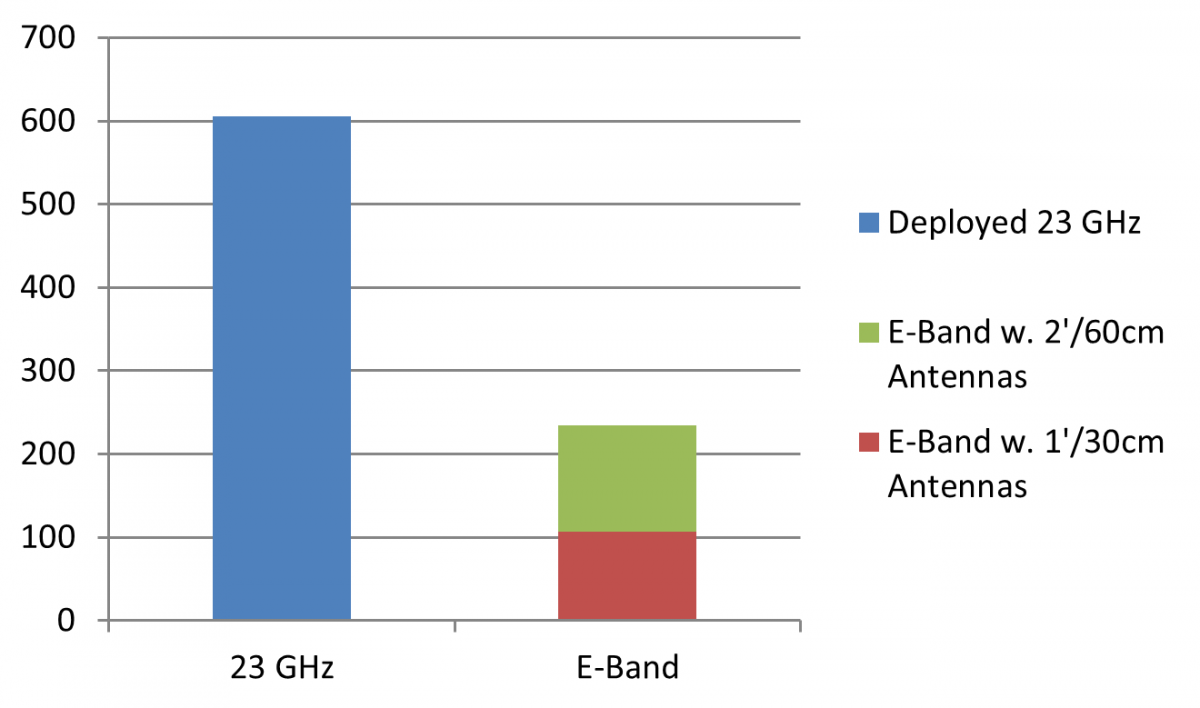E-Band for Any-G

5G Buzz – There have been some recent announcements related to 71-86 GHz (E-Band) that are generating some industry buzz, specifically point-to-point radio vendors highlighting new and advanced “5G-enabling” technologies. These solutions promote C-RAN capabilities, increased throughput upwards of 10 Gbps, and ultra-low latency. Hybrid scenarios are also starting to gain some traction, combining E-Band (for capacity) with lower frequency systems (for reach & reliability) to create a catch-all solution to support the known and anticipated demands of 5G backhaul.
While these are welcome advances, and most certainly help to promote E-Band and point-to-point backhaul as a cost-effective and reliable connectivity option, it is important to take a step back and re-visit some of the core attributes of E-Band radios, away from the glare of “5G”.
Traditional microwave has been deployed for decades with a well-defined value proposition versus leased lines and fibre trenching. By comparison, E-Band is still relatively new, and although they are neighbouring technologies that follow many of the same principles, E-Band brings several advantages over traditional 6-42 GHz microwave that should be understood.
Network operators do not have to be deploying next-generation services to take advantage of what E-Band has to offer today.
The Basics
Licensing Process
E-Band licensing varies by region and regulatory body, but in many jurisdictions E-Band links are unlicensed or follow a “Lite Licensing” process that requires a quick interference check against a database and an online registration process.
This often means that links can be deployed and turned up right away or with very little delay.
71-86 GHz Spectrum
Simply put, there is a lot of it. The 10 GHz of available spectrum is typically arranged into two 5 GHz bands: 71-76 GHz and 81-86 GHz. Depending on the regulatory body, these bands may be segmented into smaller, combinable channels, or left as large usable blocks.
The large amount of generally untapped E-Band spectrum allows for high per link capacities, extending into the multi-Gbps range. Comparable capacity in the 6-42 GHz range would require multiple radios and/or channels.
Propagation Characteristics
Other commonly unlicensed bands make use of increased signal attenuation (oxygen absorption at 60 GHz and water vapor absorption at 24 GHz). This helps to limit unwanted signals and reduce interference between links, but also results in a shorter link reach.
There is no spike in attenuation between 71-86 GHz, so E-Band instead relies on very narrow antenna beamwidths (<1° for a 30cm antenna) to help mitigate interference and achieve better frequency re-use.
Narrow antenna beamwidths significantly reduce the risk of interference and allow for efficient use of spectrum.
Today’s (and Tomorrow’s) Applications
E-Band can be especially valuable in highly congested regions where traditional microwave frequencies are becoming more and more difficult to coordinate, further acerbating the problem of increasing capacity requirements, and forcing multiple channel allocations per link.
Reviewing 606 unique 23 GHz paths in New York City, 234, or approximately 39%, could be replaced with E-Band based on their path length, highlighted in Figure 1 below:

Figure 1. 23 GHz paths in New York City with potential for E-Band substitution
These numbers were based on 23 GHz path lengths that met two criteria when substituting E-Band equipment:
- 99.99% RF link availability with > 10 dB fade margin at 2 Gbps throughput
- 99.999% RF link availability at minimum modulation (>200 Mbps)
It is also worth noting that in the United States the FCC is currently reviewing a proposal to allow smaller antennas used in 71-86 GHz bands. Factoring in 0.5’ / 15cm antennas into the study shows 56 links that would meet the pass criteria using low-profile, small form-factor antennas at each end. This could be beneficial in deployments where a wider beamwidth is required due to twist and sway of the mounting structure.
This type of study emphasizes the use case for E-Band and becomes even more attractive in regions where traditional microwave spectrum is both congested and expensive. In the UK, for example, a 1km 38 GHz link using a 28 MHz channel (delivering ~200 Mbps of capacity) may cost upwards of 18 times more in annual spectrum licensing costs than an E-Band link delivering 12 times the capacity.
Major Takeaway Points
For modest path lengths, E-Band point-to-point links offer:
- Reliable, carrier-grade connectivity
- High capacity in the multi-gigabit per second range
- Ultra-low link latency
- Interference-free operation
- Quick turn-up
- Low spectrum costs
- Simple configurations (no sub bands, simply one High Radio and one Low Radio in FDD)
While E-Band is a great fit to support the capacity and performance requirements of next-generation services, it is important to consider E-Band as an “any-G” technology, demonstrated by the respectable and growing number of worldwide deployments in the last 10 years or so.
Any network operator, utility, WISP, or enterprise seeking to transmit high amounts of reliable data between two points (having line of sight) should consider adding E-Band, and the value it brings, to their toolbox.
